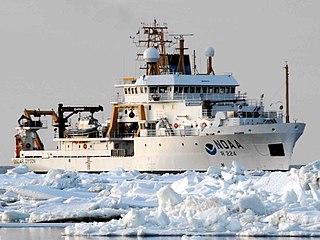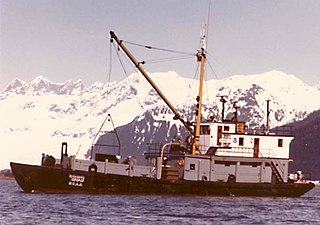
The United States Fish and Wildlife Service is an agency within the United States Department of the Interior dedicated to the management of fish, wildlife, and natural habitats. The mission of the agency is "working with others to conserve, protect, and enhance fish, wildlife, plants and their habitats for the continuing benefit of the American people."

The Office of Marine and Aviation Operations (OMAO) is a division of the National Oceanic and Atmospheric Administration (NOAA) which operates a wide variety of specialized ships and aircraft to carry out the environmental and scientific missions of NOAA.

The United States Fish Commission, formally known as the United States Commission of Fish and Fisheries, was an agency of the United States government created in 1871 to investigate, promote, and preserve the fisheries of the United States. In 1903, it was reorganized as the United States Bureau of Fisheries, sometimes referred to as the United States Fisheries Service, which operated until 1940. In 1940, the Bureau of Fisheries was abolished when its personnel and facilities became part of the newly created Fish and Wildlife Service, under the United States Department of the Interior.

NOAAS Ronald H. Brown is a Thomas G. Thompson-class blue-water research vessel of the U.S. National Oceanic and Atmospheric Administration, she is NOAA's only Global-Class research ship.

NOAA Ship John N. Cobb was a National Oceanic and Atmospheric Administration research vessel in commission from 1970 to 2008. She was named for John Nathan Cobb and was the oldest commissioned ship in the NOAA fleet when she was decommissioned, having previously served in the United States Department of the Interior′s Fish and Wildlife Service from 1950 to 1956 and in the United States Fish and Wildlife Service′s Bureau of Commercial Fisheries from 1956 to 1970 as US FWS John N. Cobb.

USNS Adventurous (T-AGOS-13) was a Stalwart-class modified tactical auxiliary general ocean surveillance ship of the United States Navy in service from 1988 to 1992. She was in non-commissioned service in the Military Sealift Command from 1988 to 1992, operating during the final years of the Cold War. She was transferred to the National Oceanic and Atmospheric Administration (NOAA) in 1992 and in 2003 was commissioned into service with NOAA as the fisheries research ship NOAAS Oscar Elton Sette.

USNS Relentless (T-AGOS-18) was a Stalwart-class modified tactical auxiliary general ocean surveillance ship in service in the United States Navy from 1990 to 1993. Since 1998, she has been in commission in the National Oceanic and Atmospheric Administration (NOAA) fleet as the fisheries research ship NOAAS Gordon Gunter.

NOAAS Reuben Lasker is a National Oceanic and Atmospheric Administration (NOAA) fishery research vessel. The ship's namesake, Reuben Lasker, was a fisheries biologist who served with the Southwest Fisheries Center, National Marine Fisheries Service, and taught at the Scripps Institution of Oceanography. This class of NOAA ships is very similar to, and based in part upon, the Neil Armstrong-class Oceanographic Research (AGOR) ships owned by the Office of Naval Research and operated by various US Universities.

NOAAS Oregon II is an American fisheries research vessel in commission in the National Oceanic and Atmospheric Administration (NOAA) fleet since 1977. Prior to her NOAA career, she was delivered to the United States Fish and Wildlife Service's Bureau of Commercial Fisheries in 1967 and was transferred to NOAA in 1970, but was not placed in commission until 1977.

NOAAS Townsend Cromwell was an American fisheries research vessel that was in commission in the National Oceanic and Atmospheric Administration (NOAA) fleet from 1975 to 2002. Prior to her NOAA career, she was in the United States Fish and Wildlife Service's Bureau of Commercial Fisheries fleet from 1963 to 1975 as US FWS Townsend Cromwell.

NOAAS Chapman was an American fisheries research vessel that was in commission in the National Oceanic and Atmospheric Administration (NOAA) fleet from 1980 to 1998. After the conclusion of her NOAA career, she spent several years operating as the University of Puerto Rico marine research vessel R/V Chapman. More recently, she has become the Curaçao-based mothership for the deep-diving submarine Curasub.

NOAAS David Starr Jordan (R444)) was an American fisheries research vessel in commission in the National Oceanic and Atmospheric Administration (NOAA) from 1970 to 2010. She previously was in the United States Fish and Wildlife Service's Bureau of Commercial Fisheries fleet from 1966 to 1970 as US FWS David Starr Jordan.

NOAAS Oscar Dyson is an American fisheries and oceanographic research vessel in commission in the National Oceanic and Atmospheric Administration (NOAA) fleet since 2005.

NOAAS Pisces is an American fisheries and oceanographic research vessel in commission in the National Oceanic and Atmospheric Administration (NOAA) fleet since 2009.

NOAAS George B. Kelez, previously NOAAS George B. Kelez, was an American research vessel in commission in the National Oceanic and Atmospheric Administration (NOAA) fleet from 1972 to 1980. Prior to her NOAA career, she operated under the United States Fish and Wildlife Service′s Bureau of Commercial Fisheries from 1962 to 1970 as US FWS George B. Kelez and the National Marine Fisheries Service from 1970 to 1972 as NOAAS George B. Kelez.

NOAAS Murre II, previously NOAAS Murre II, was an American research vessel in commission in the National Oceanic and Atmospheric Administration (NOAA) fleet from 1970 to 1989. Prior to her NOAA career, she operated under the United States Department of the Interior′s Fish and Wildlife Service from 1949 to 1956 and under the United States Fish and Wildlife Service′s Bureau of Commercial Fisheries from 1956 to 1970 as Murre II.

US FWS Pribilof was an American refrigerated cargo ship in commission in the fleet of the United States Fish and Wildlife Service (USFWS) from 1964 to 1970 and, as NOAAS Pribilof, in the fleet of the U.S. National Oceanic and Atmospheric Administration′s National Marine Fisheries Service (NMFS) from 1970 to 1975. She ran a cargo service between Seattle, Washington, and the Pribilof Islands – the last of the United States Government "Pribilof tenders" to carry out this function – and also made USFWS and NMFS research cruises in the Pribilofs.

MV Brown Bear was an American research vessel in commission in the fleet of the United States Department of Agriculture′s Bureau of Biological Survey and Alaska Game Commission from 1934 to 1940 and in the fleet of the United States Department of the Interior′s Fish and Wildlife Service from 1940 to 1942 and from 1946 to 1951, under the control of the University of Washington from 1952 to 1965, and in commission in the fleet of the United States Fish and Wildlife Service from 1965 to 1970 and of the National Oceanic and Atmospheric Administration′s National Marine Fisheries Service (NMFS) from 1970 to 1972.

USFS Pelican was an American fisheries science research ship and fishery patrol vessel that operated along the United States East Coast and the United States Gulf Coast and in the waters of the Territory of Alaska. She was part of the United States Bureau of Fisheries (BOF) fleet from 1930 to 1940. She then served as US FWS Pelican in the fleet of the Fish and Wildlife Service – from 1956 the United States Fish and Wildlife Service – from 1940 to 1958. She served as a fishery patrol vessel while on loan to the Washington Department of Fish and Wildlife from 1958 to 1970, then briefly returned to the Fish and Wildlife Service's successor agency, the National Marine Fisheries Service. Her United States Government service ended when she was sold into private hands in 1972, and she remained extant as of 2010. In 2017 Captain Patrick Burns and Captain John (Johnny) Sylvester purchased the Pelican from Marilyn Masland. She is currently moored in Deer Harbor on Orcas Island, WA. In 2018 she was brought up the Inside Passage to Alaska and back to Washington.




















